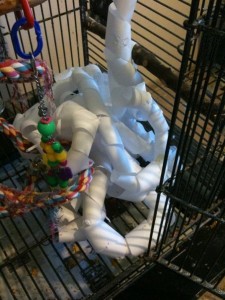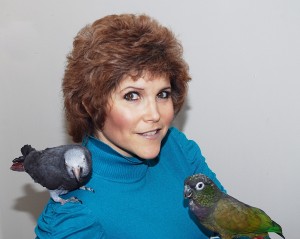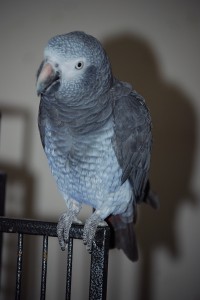pet parrot
Enriching Your Parrot’s Environment
NOTE: I have a new pet behavior blog located at http://www.SoMuchPETential.com/blog. Thanks!
I was looking at Barnaby’s cage the other day and it occurred to me, there are some ‘toys’ in there that he hasn’t touched. He definitely looked like a little, mischievous guy who needed more to do with his time. So I refilled the adding machine paper roll  holder, wrapped newspaper around the bars and filled an old sock with food.
holder, wrapped newspaper around the bars and filled an old sock with food.
Guess what I found when I returned? A huge pile of adding machine paper on the cage floor, shredded newspaper, and an old sock with huge holes in it.
Yep, I’m figuring it is about time for a reminder about the importance of making our parrots’ environments enriching.
Remember, these are animals that would spend hours every day in the wild searching for food, flying, raising young, or watching out for predators. We take them into our homes, put them in cages and want them to be quiet, non-destructive inhabitants.
They rely on us to not only provide them with safety and nourishment, but also to keep them busy and stimulated. And, if we let our birds down by not providing them these basic needs, then who can we ‘really’ blame if our pets develop behavior issues.
Robin Shewokis, owner of the Leather Elves who helps zoos and other facilities create enriching environments, once told me some considerations to keep in mind are: knowing your bird’s natural history (for example, cockatiels are ground foragers so putting foraging activities high in a cage isn’t the best idea); providing activities that stimulate as many senses as possible; and knowing your specific bird (because really behavior is individual) so that you can give him activities he will interact with. (Remember you can also teach a bird to interact with something – and training is a great enrichment activity for both you and your pet.)
For example – I know Barnaby loves to hang upside, loves to try and figure things out, he chews some especially paper, and he loves bells. When his cage door is open he spends a lot of time hanging upside down from his toy hanger attached to the cage.
So, inside his cage, I have a number of bells. There are beads strung (with knots in between) on hemp string and tied around his cage, paper rolls, food in different bowls, etc. On the bottom of his cage I have a human baby toy that is a cup with a mirror on the bottom which is hung from the bars and filled with some pellets. Many days I find just crumbs so I know he is busy exploring.
Keep in mind, enrichment does not have to be super expensive. I always tell the story of the time I bought $50 worth of toys online. When I opened the box, the first thing Barnaby grabbed was the receipt page…and he played with it for 10 minutes!
Be creative and have fun, but also please keep safety in mind.
Link to great enrichment activity book.
Power Of Positive Reinforcement To Solve Parrot Screaming
NOTE: I have a new pet behavior blog located at http://www.SoMuchPETential.com/blog. Thanks!
This is one of my past Hyde Park Living pet behavior columns. Sadly Chester is no longer with us but I thought this information was important to share.
Every once in awhile you get to read about one of my own personal stories. This happens to be one of those times. I felt like I needed to write this for all of those people out there who think you can’t teach an old dog new tricks - or for that matter, birds - and for everyone, who blames their pets’ behavior issues on their pet.
 This is the story of my dad and my birds, Chester and Dreyfuss in particular. Three totally different living beings, all of whom I care very much about, but until recently didn’t care much for each other. In fact, it would be a fair argument to say that description was being polite.
This is the story of my dad and my birds, Chester and Dreyfuss in particular. Three totally different living beings, all of whom I care very much about, but until recently didn’t care much for each other. In fact, it would be a fair argument to say that description was being polite.
In case you’re new to my column, I’ve got three beautiful birds – Barnaby is my Timneh African Grey, Chester is my Alexandrine Ringneck, and Dreyfuss is my Maximillum Pionus. Of course, everyone loves Barnaby, my little grey talking teddy bear. But for the 11 plus years that I’ve had Chester, my dad has never been fond of him. It’s actually kind of been a mutual thing. My dad would walk in the door and Chester would scream. Then the minute Chester would scream, my dad would say, “I can’t stand that scream.” And shy little Dreyfuss would just run to the farthest corner of her cage and sit totally erect until danger left the room.
I’ve been a student of animal behavior for many years. I consider myself very fortunate to have met and learned from internationally renowned behaviorist Dr. Susan Friedman and trainers who use only positive reinforcement techniques – Steve Martin and Barbara Heidenrich. Through them I’ve learned that it’s not only possible, it’s most effective to change behaviors in the least intrusive, most positive way – without the use of punishment.
Earlier this year, armed with my new found knowledge, I was determined to change that unhealthy relationship. And, you know what, it not only worked, we were able to correct a problem over a decade old in less than a week.
Before I explain our plan, let me explain my thought process. Number one was that in any modification plan, it’s very important that you always progress at the pace and comfort level of the bird. In other words, my dad was to stop moving toward any of the birds as soon as he noticed a sign of distress (like feathers puffed, leaning away, etc.). In giving a bird a seed, he was to stand arms distance away waiting for the bird to ‘invite’ my dad into his space with body language (leaning toward him, etc.) Number two was that it was very important to not reinforce Chester’s screaming behavior, while also immediately and consistently reinforce Chester for being quiet every time. And thirdly, was to keep in mind that for the time being anyway, I was much more rewarding to the birds than my dad.
Here is a condensed version of our plan. When we walked into the birds’ room, both my dad and I had seeds. We walked toward Barnaby’s cage (me on the side closest to Chester), completely ignoring Chester who started to scream, while lavishing Barnaby with attention and seeds for his being quiet and willingly accepting seeds. The second that Chester stopped screaming *I* turned around and gave him a seed. If my dad turned around and Chester screamed, we’d both calmly turn our backs and continue doting on Barnaby. Eventually we wanted to phase in my dad being able to turn around and give Chester seeds.
Chester’s a pretty smart guy. Because of the immediacy with which I reacted to his either being quiet or screaming, he was able to develop a relationship in his mind fairly quickly that *if* I scream, *then* Lisa and her dad will ignore me but *if* I am quiet *then* I get seeds. Within a matter of 10 minutes in the very first session, my dad was already able to give Chester a seed (from an outstretched arm). Chester also did his *stand tall* and *wave* for me in front of my dad.
The second day went even better, and by the third day, a magical thing happened. For the first time in more than 11 years, my dad walked into their room and not only were none of them displaying any level of discomfort, they were actually showing signs of eagerness. Chester immediately began *standing tall* and *waving* and Barnaby just kept turning round in circles (one of his tricks). Even Dreyfuss, was at the front of her cage leaning forward toward my dad. And, not one single scream. Instead of relating my dad to negative experiences, they were associating him with positive reinforcement. It was absolutely an amazing moment. I never thought I’d see the day that my dad would ask to feed the guys seeds – or the day that the guys would be eager to see my dad. But it has definitely happened.
I hope that my story will serve to inspire other pet owners, especially those who believe in the power of punishment because it’s the power of positive reinforcement that we should focus on instead.
Should Pet Birds Be Allowed On Shoulders?
NOTE: I have a new pet behavior blog located at http://www.SoMuchPETential.com/blog. Thanks!
I’d like to address a question that is often asked by those who have birds.
Should birds be allowed on shoulders?
Well, let’s first ask – is there really such a thing as height dominance?
Steve Martin, renowned trainer and president of Orlando-based Natural Encounters, wrote about it in a paper actually. “To put it bluntly,” he said, “height dominance does not exist in parrots.”
put it bluntly,” he said, “height dominance does not exist in parrots.”
Talking to those in the know – ornithologists, field biologists, and wild bird behaviorists – there is no such thing as an alpha parrot. Aggression between wild parrots is brief, and a parrot that loses in one confrontation may very well win in the next.
A frustrated bird owner may question that. “Well, of course my bird gets dominant when he’s up high. He bites me every time I try to pick him up from somewhere high,” that person may say.
My response to that? Let’s do a little behavior analysis and look at a scenario that bird owners frequently use as an example of their pet showing ‘dominance’. Butch – a macaw – is on top of his cage playing with a toy when his owner, Suzy, needs to put him into his cage. She reaches for him and when he steps up, ‘without any warning’ (as is often described) he nails her.
Let’s look at some potential things that could be coming into play here.
• Birds are more comfortable stepping up. However since Butch is up high, unless Suzy gets on a chair, more than likely he is needing to step down to her and may even catch his long tail on the cage. Not very fun for Butch.
• Butch was perfectly happy playing with his toys. His past experience of stepping up for Suzy when he’s playing with his toys is that the consequence of his stepping up means he goes into his cage more often than not. And being inside that cage is just not as fun as being on top of it. (He’s at least taken away from doing something that he was enjoying doing.)
• Before Butch actually bit Suzy, he tried to show her he didn’t want to step up by pinning his eyes or other body language but she ignored or didn’t pay attention to it. Therefore biting her is the only behavior he can do to get the message across that he really does not want to step up at this time.
So, now, is this really a case of height dominance or is the bird simply behaving to escape something negative from the bird’s point of view?
Now back to the original question. Is it okay to wear your bird on your shoulder?
Well, there are a number of factors to take into consideration with regard to that decision. None of them have to do with height dominance.
• What is your relationship with your bird? Does your bird reliably ‘step up’ onto your hand?
• One problem with having your bird on your shoulder is that you can’t see his body language. Therefore you can’t effectively allow your bird to communicate a fear or aggressive response, thus you may be setting both of you up for a possible bite.
• Another consideration is that, while it’s fun companionship to wear shoulder birds it’s healthy to offer a variety of enriching activities for your pet that encourage independent play, foraging, and more. Encouraging your bird to stay perched in one place for long periods of time limits the time he could be learning and playing in different ways.
Right now I only allow Barnaby on my shoulder. Dreyfuss is my hand bird. While both of my birds are fairly fluent in ‘step up’ (Barnaby much more so than Dreyfuss, although she’s getting better), Barnaby has a much more predictable calm behavior than Dreyfuss. It’s not so important for me to keep an eye on Barnaby’s body language. However, Dreyfuss can be a little on the unpredictable side. It’s very important for me to watch her body language as I have her ‘step up’, therefore it is not a good idea for her to perch on my shoulder.
I do want to just mention that if it is a goal of yours to wear your parrot on your shoulder, a good first goal would be to teach a reliable ‘step up’ behavior.
Solving Problem Parrot Screaming
NOTE: I have a new pet behavior blog located at http://www.SoMuchPETential.com/blog. Thanks!
(a past Hyde Park Living column)
Screaming is one of those behaviors many bird owners complain about because they can’t seem to get the behavior to stop. And let’s face it…that noise isn’t exactly pleasant – at least to most of us.
Eleven years ago I was among the statistic of those who blamed Barnaby for making a noise I couldn’t live with. Just like so many other bird owners, I tried everything I had heard to try. I tried putting him in his cage, talking to him in quiet words, telling him “no”, ignoring him. All to no avail. I was at the end of my rope when I stumbled upon Susan Friedman, Ph.D. and her behavior teachings. Not only has my whole relationship with my pets changed as a result, she has sparked this passion in me to educate  others about using positive, scientifically proven strategies for modifying behavior.
others about using positive, scientifically proven strategies for modifying behavior.
What Susan teaches is that we’ve got to stop looking for answers by labeling behaviors or birds, or species generalities. It serves no purpose in helping to get at the root of the problem. The bottom line is that ALL behavior has function. No matter what the behavior is – whether it’s biting, not stepping up, chewing on furniture, or screaming – something occurred immediately prior to the act (antecedent) that may serve to “lead to” it, and something occurred immediately after the act (consequence) that impacts whether or not the behavior will be repeated in the future.
We, as teachers, can influence behaviors by changing the environment including antecedents and consequences.
All of my earlier attempts, I was taught, were actually reinforcing his screams – definitely why he had never stopped screaming. There’s a scientific word for what I had been doing. It’s called “intermittent reinforcement”, meaning, sometimes I gave him attention for screaming without even realizing it. Intermittent reinforcement make a behavior more resistant to change (think of the addiction of the slot machine in a casino).
My challenge as Barnaby’s teacher, was to provide him with a more stimulating and satisfying alternative to his screaming. In summary, it boiled down to three basic steps –
1) Ignore all screaming. Period. No attention at all, if I’m in the room, I calmly walked out with the other birds. With this step, I had to be prepared for an “extinction burst” where he screamed even louder to try to get my attention. Under no circumstances could I give in and go to him during this, or his problem would only worsen. The contingency I wanted Barnaby to learn was, “When” I scream “Then” the room is evacuated.
2) DRA or differential reinforcement of an alternative behavior. Each and every time Barnaby would make a chosen sound (at first it was a whistle, then changed it to “mommy here”), I was immediately there with reinforcement. The contingency I wanted Barnaby to learn with this was “When” I make this sound “Then” mom gives me attention. Eventually I got to where I don’t come each time, sometimes I’ll tell him I’m busy.
3) Thoughtful arrangement of the environment. I needed to make sure Barnaby had enough activities that HE was interested in to keep him busy. When I left his room, in the beginning, I would give him something to keep his mind occupied until I was out of sight. If he wasn’t interested in what I had given him, it meant that his gift wasn’t as stimulating to him as calling out to me, and so I had to find something else that was.
It has now been ten years since I first started learning about this. And I’ve got quite a little chatter box in my home. People ask me why Barnaby talks so much and I tell them it is because he gets attention when he talks. When he screams he gets no attention.
Of course there are still moments when the birds scream, they are, after all birds. But it is more the exception than the rule now.














